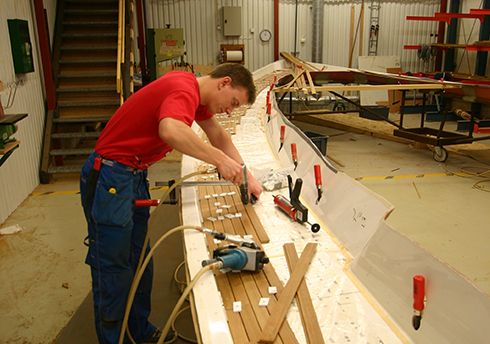Hallberg-Rassy

Being afflicted by an affection for wooden boats, Ive always been perplexed by the faux teak trend. In my book, youre either in love with wood and you pay for your love in labor, or you bow to the apparent pragmatism of plastic. For me, a boatbuilder who is seduced by a synthetic wood deck or trim is akin to Ferdinand the Bull ecstatically romping through a field of plastic flowers-that is to say, more than a little confused. Faux teak has neither the aesthetic appeal of teak, nor the durability of other boat-building materials used instead of teak. So who the heck wants this stuff?
This question began to really bug me last week after a visit to the factory for Teak Decking Systems, the best-known domestic supplier of real teak decks, where I learned even this company was branching into plastics. Later that week, as I strolled the Tampa Convention Center where the International Boatbuilders Exhibition and Conference was in full swing, I discovered no less than six booths manned by seemingly reasonable salesman proudly selling faux teak decking.
I drove home in a funk, depressed by the thought that the fungible reality that is at the heart of twenty-first century politics, economics, and best-selling memoirs has found a permanent home on the entry-level sailboat. Yes, perhaps from a distance, a landlubber might mistake fake teak for something real-but if that is all that faux teak is good for, who would bother with it? Sailors generally don’t strike me as people who are out to impress the huddled masses gazing wistfully from the shore.
As it turns out, there is a perfectly sensible answer to my question-but first, here is a short list of the companies I bumped into at IBEX who are happily engaged in the faux teak trade: Ameriteak Flexiteek, Permateek, and Plasteak. Our last comparison of synthetic teak decks included samples from TekDek, and the cork-based Marinedeck 2000. Another product on the market is Nuteak. I noticed some nuanced differences among the products, but not enough to persuade me one is better than the other. Some testing will no doubt sort that out.
Photo courtesy of Permateek

Given the growing interest in synthetic deck material (our recent test of non-skid coatings and the 12-month update included several synthetics), well be looking at these products again. Im sure there are a few players in the synthetic teak world that Im missing here, so if you have some product recommendations, just add a comment below. One of the key characteristics we looked at in our last test was durability. Well look at this again, but were also interested in resistance to chemicals and UV exposure.
Ive blogged about the diminishing amount of wood on contemporary boats before. That post focused primarily on items such as toe-rails, handholds, and trim. Most people who left comments were delighted to be free of the drudgery of teak maintenance. I wonder if these same people would look longingly toward a faux-wood alternative instead of the more common substitutes-fiberglass, stainless steel, aluminum, or Starboard? If youre shying away from wood, why try to hide it? Or is there something else at work here?
According to the people I spoke with at Teak Decking Systems and IBEX, the biggest market for synthetic woods in the marine industry is not sailboats builders, but poweryacht and cruise ship builders looking for cost-effective substitutes for teak. That makes sense. Excepting perhaps for the trawler crowd, it seems obvious that the notion of a synthetic product would carry fewer negative connotations for powerboaters and cruise ship patrons. (Who would complain about ersatz wood when Goofy and Mickey are cavorting on the Lido Deck?)
So, poweryachts and cruise ships are the market drivers. The why question is harder to answer. Cost of materials and installation is certainly an important factor. When building a new boat, the teak deck accounts for a large share of the materials costs. And when replacing an old teak deck, the cost of new teak deck can exceed the boat’s market value.
While the initial outlay for a synthetic deck may be relatively low, Teak Decking System contends that this initial cost conceals the full price it exacts from the environment. The company argues that if you take into account the VOC emissions during synthetic wood production and the way teak plantations offset carbon emissions, manufacturing with real teak leaves a smaller carbon footprint.
But cost alone is not driving the switch to synthetics in new boats. Tastes are also shifting. For decades, teak has been a closely regulated plantation product, with trees cultivated to meet specific grades. However, as demand has increased, the quality of the wood is dropping. Higher moisture content and irregularities in color are appearing more frequently. This adds hours and cost to the selection and installation process. Purchasers of high-priced yachts who are accustomed to uniform grain and color in their teak decks have been forced to pay through the nose, or adjust their expectations.
Interestingly, the variability and flaws in real teak is what still draws many builders to the material. For them, the random shades of gold and brown serve as a constant reminder that the world we live in is an imperfect one-not plastic.





































Looking for the best 3m self stick nonskid
floor for marine use on decks!
What are your suggestions?